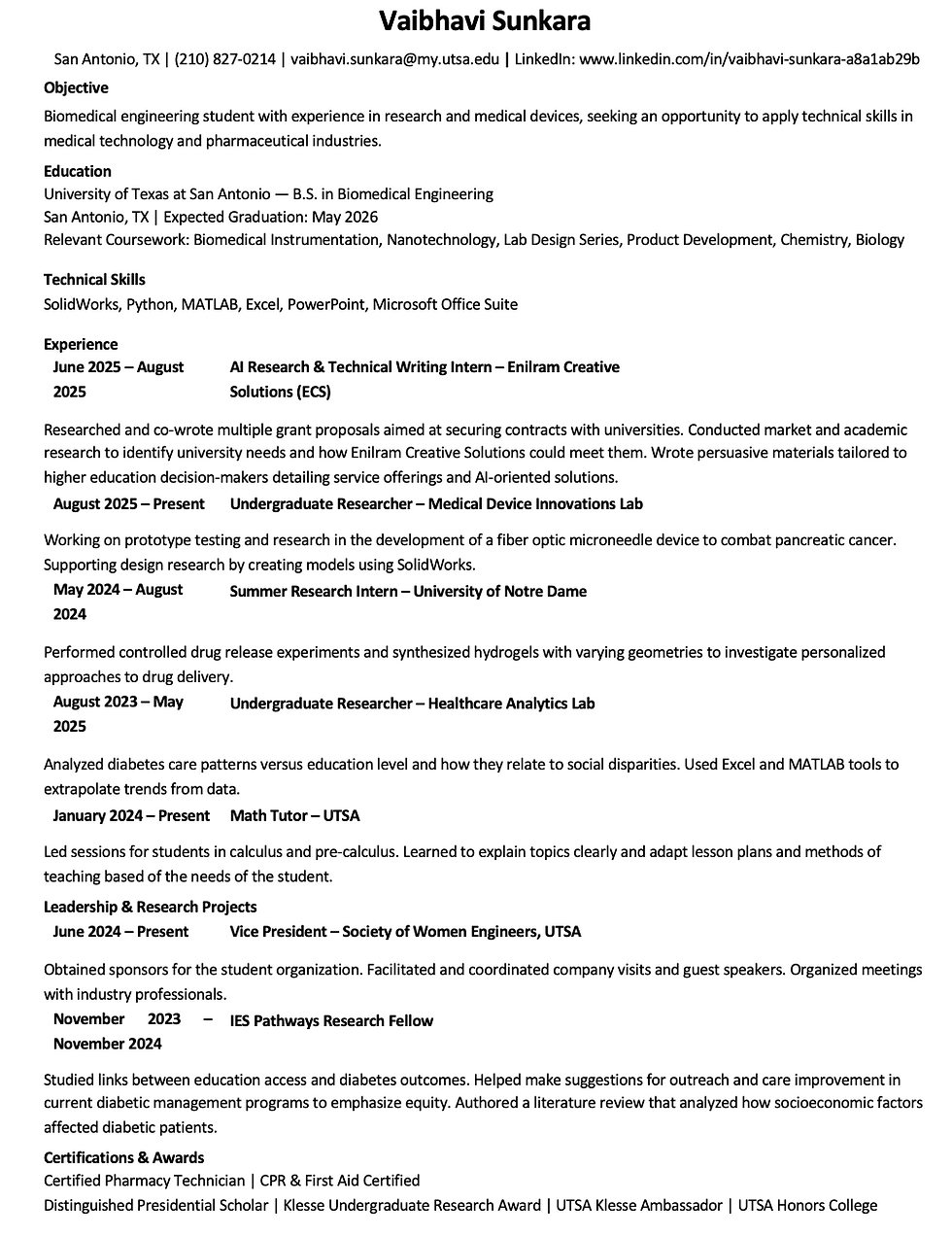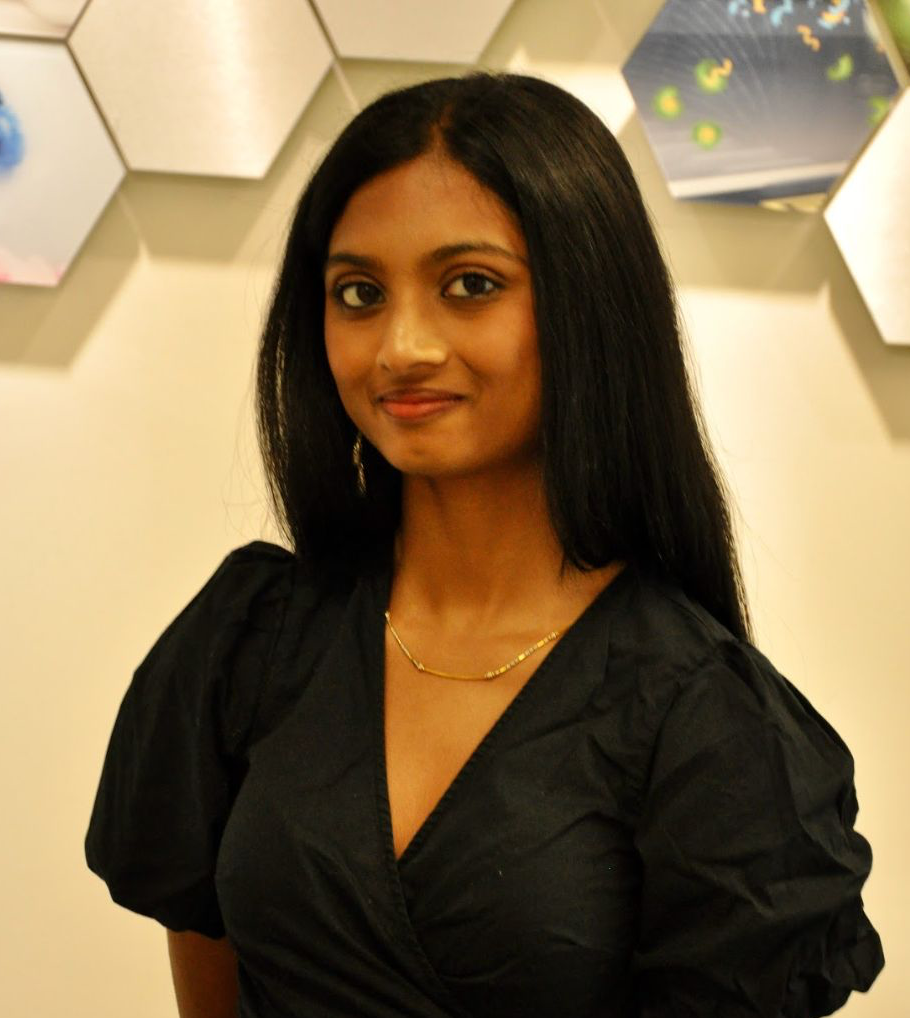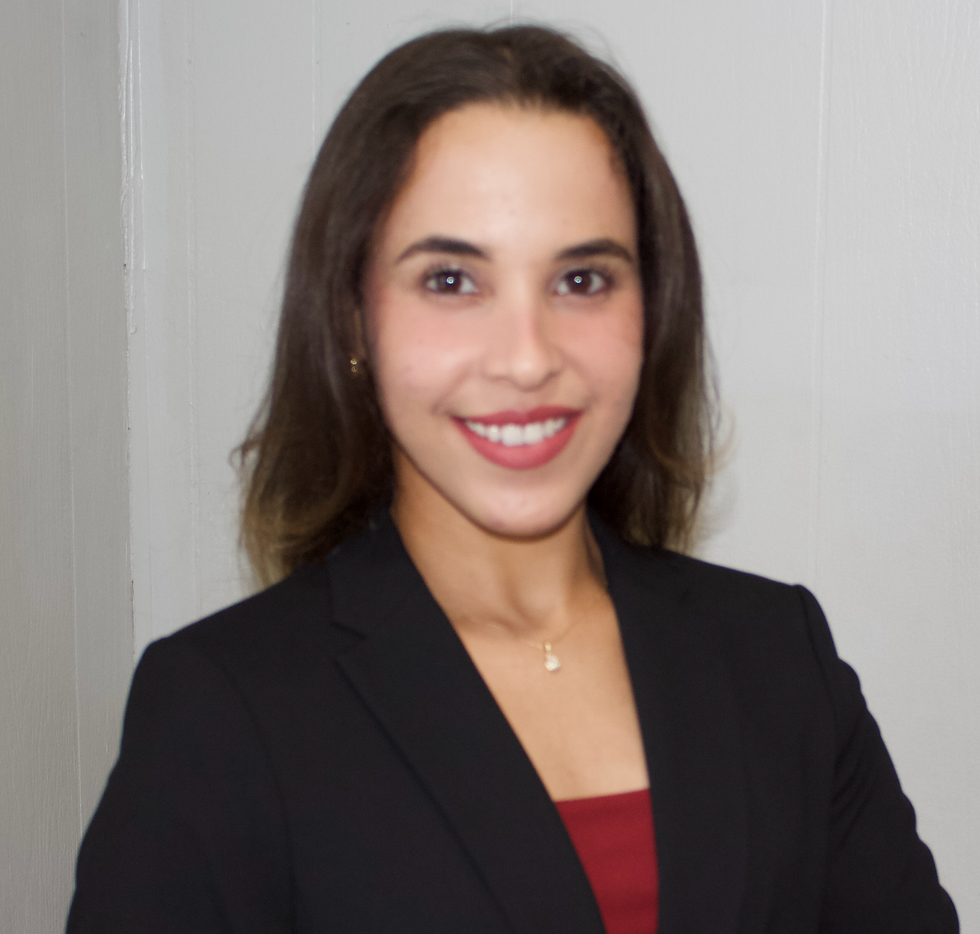Integrating AI and Innovation: My ECS Internship Journey
- Sep 30
- 6 min read

My ECS Journey:
My name is Vaibhavi Sunkara, and I am a student at the University of Texas At San Antonio. I have just completed my 16-week internship with Enilram Creative Solutions as a Research and Grant Writing intern. During my time at ECS, I enjoyed learning about the possibility of implementing AI into research and making the process more efficient. My journey taught me to think independently to approach problems from multiple perspectives and adapt quickly to new challenges. This experience strengthened my interest in combining my previous knowledge with emerging technologies, and I look forward to applying these skills in future research and innovation opportunities.
AI in Action - LinkedIn Profile Transformation:
Prior to my internship, my LinkedIn profile was far from being an effective professional tool. It was essentially inactive and lacked the engagement that is crucial for networking in today’s job market. I had not taken the initiative to connect with anyone in my industry or beyond, missing out on valuable opportunities to expand my professional network.
My profile mainly consisted of a brief outline of my experiences, listing my previous roles and responsibilities without much elaboration or personal branding. This lack of detail meant that my profile did not convey my skills and accomplishments. As a result, my online presence was not leveraging the platform's full potential, leaving me at a disadvantage in a competitive job market where networking and visibility are key.
To transform my LinkedIn, I began by reviewing my original LinkedIn profile and identifying areas that felt vague or lacked measurable impact. My goal was to make my profile more professional and tailored to biomedical engineering and research opportunities. Moreover, I asked AI to rate my current profile on a scale of 1-10 and made sure to ask for feedback on the score received. I used AI as a drafting partner, starting with broad prompts such as, “Rewrite my LinkedIn summary to highlight my biomedical engineering experience, AI integration internship, and research background.”
After receiving the first draft, I refined my prompts to be more specific, asking, “Make this summary concise and professional, emphasizing drug delivery, medical device research, and AI integration,” and “Turn this internship description into a bullet point with action verbs and measurable outcomes.” Through three main iterations, I was able to refine the content: the first draft was too general, so I redirected the AI to make it specific to the career fields that I was interested in, and the second draft was more focused but still wordy, so I asked for conciseness and stronger verbs.
Lastly, the final draft was streamlined and polished, with my long-term career goals. In the end, I achieved an optimized LinkedIn profile that clearly communicates my research and internship accomplishments, uses stronger action verbs and measurable outcomes, and positions me for future opportunities in biomedical engineering and research.
Through this, I was able to get more connections and even a few direct messages asking me for more information regarding my profile. I started off with less than 50 connections, and after enhancing my profile, I was able to add over 150 more people to my network. Additionally, within two weeks of updating, I saw a noticeable increase in profile views and connection requests from industry professionals.



Section 3: AI in Action - Resume Enhancement
I realized that my original resume bullets were vague and my experiences were limited. For example, I only mentioned 2 research projects and 1 job experience. Moreover, it was too wordy and looked unprofessional for the field of research.

I used AI to refine these statements and experiences to make my resume stand out more and represent that work and experience that I have. By prompting the AI with instructions like “Rewrite this bullet to highlight strategy, measurable outcomes, and professional impact,” I was able to iteratively improve each draft. For example, the first draft became “Assisted in drafting grant proposals and researching potential university clients,” and after further refinement, the final bullet read, “researched and co-wrote multiple grant proposals aimed at securing contracts with universities. Conducted market research to identify university needs and how Enilram Creative Solutions could meet them” I applied the same process to other responsibilities, transforming bullets about teaching students math into outcome-oriented statements that highlighted my contributions, skills, and the impact of my work. This strategic prompting approach allowed me to turn broad or generic descriptions into polished, measurable, and professional resume content.
As a result, my enhanced resume clearly communicates my experiences and what I gained from each of them rather than just stating what I did. Now, the resume demonstrates both the skills I gained and the tangible outcomes I achieved, while positioning me for future opportunities in biomedical engineering and research-focused roles.

My Best ECS Project
The objective of the project was to secure new contracts with universities by crafting tailored grant proposals and outreach materials that showcased Enilram Creative Solutions' expertise in AI integration. The challenge involved identifying universities with strong AI programs and aligning ECS's services with their needs.

I conducted in-depth research to identify universities with robust AI programs, such as Stanford University, University of California, Berkeley, and Carnegie Mellon University. I then wrote proposals and developed a pitch deck aimed at positioning ECS as a preferred partner for these institutions.

I utilized AI tools to enhance various aspects of the project. First, I optimized the research process by using AI to analyze university websites and academic publications, extracting key information about their AI initiatives and identifying potential areas where ECS could offer value. I then used AI to draft and refine proposal language, ensuring clarity, professionalism, and alignment with each university's objectives. Lastly, I leveraged AI to finalize content for the pitch deck, including executive summaries, value propositions, and visual elements that effectively communicated ECS's capabilities.

This project was impactful because we were able to develop targeted grant proposals that positioned ECS as a competitive partner for universities with strong AI programs. Moreover, creating a compelling pitch deck that effectively communicated ECS's capabilities, leading to increased interest from potential university clients.
The project demonstrated the power of AI in streamlining research, enhancing content quality, and improving communication strategies. It reinforced the importance of aligning services with client needs and effectively conveying value propositions. Additionally, it highlighted the potential of AI to support strategic decision-making and business development efforts.
Growth & Learning Journey
When I began my internship at Enilram Creative Solutions I had a solid foundation in research and writing but limited experience applying AI tools in a business context or crafting strategic proposals for higher education clients.
Over the course of the internship, I experienced several key breakthroughs. I learned to identify potential clients, analyze their needs, and translate research into persuasive, outcome-driven proposals. I developed practical skills in AI integration and learned to use tools such as ChatGPT to draft and refine grant proposals, Gemini to generate creative content ideas, Perplexity to quickly gather research insights on university programs, and Napkin AI to design and enhance pitch decks. My understanding of business development grew as I learned how to position ECS’s services strategically and communicate value persuasively. Through this process I embodied ECS’s values of innovation, collaboration, and impact by taking initiative and iterating on ideas with feedback all while focusing on solutions that deliver measurable results. My professional confidence grew substantially as I became comfortable presenting ideas, refining strategies, and leveraging AI to enhance my work.
By the end of the internship I had strengthened both my technical capabilities, such as AI-assisted research and proposal drafting, and professional skills, like strategic thinking and problem-solving. I also gained industry insights into how creative solutions and AI can drive innovation in higher education which prepared me to approach future research and business challenges with a more informed perspective.
My Future & ECS Impact
Looking ahead, I plan to pursue a career in biomedical engineering with a strong focus on research and development in drug delivery and medical devices. My internship at Enilram Creative Solutions gave me valuable experience in integrating AI into real-world projects, which strengthened my ability to approach problems creatively and strategically. The ECS AI Integration Specialist credential shows that I can apply AI tools to enhance research, communication, and business development, and it has prepared me to bring that skillset into both technical and professional environments.
To future ECS interns, I would say to take full advantage of the chance to explore AI, experiment with different tools, and not be afraid to learn by doing. This program pushed me outside my comfort zone and gave me the confidence to combine innovation with practical impact. I am excited to continue building on this foundation as I move toward my professional goals.
I always welcome opportunities to connect with others who share an interest in AI and biomedical research, and I can be reached on LinkedIn at www.linkedin.com/in/vaibhavi-sunkara-a8a1ab29b.

.




Comments